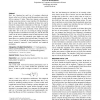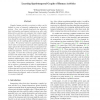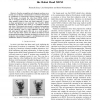125 search results - page 19 / 25 » View-Invariant Modeling and Recognition of Human Actions Usi... |
CHI
2005
ACM
14 years 8 months ago
2005
ACM
Fitts' law, Steering law and Law of crossing, collectively known as the laws of action, model the speed-accuracy tradeoffs in common HCI tasks. These laws impose a certain sp...
CVPR
2010
IEEE
14 years 3 months ago
2010
IEEE
A central problem in the analysis of motion capture (Mo-
Cap) data is how to decompose motion sequences into primitives.
Ideally, a description in terms of primitives should
fac...
ICMCS
2006
IEEE
14 years 1 months ago
2006
IEEE
Automatic facial expression analysis is an important aspect of Human Machine Interaction as the face is an important communicative medium. We use our face to signal interest, disa...
ICCV
2011
IEEE
12 years 7 months ago
2011
IEEE
Complex human activities occurring in videos can be defined in terms of temporal configurations of primitive actions. Prior work typically hand-picks the primitives, their total...
IROS
2007
IEEE
14 years 1 months ago
2007
IEEE
— Emotion recognition and adequate reactions are a crucial part of human communication and hence should also be considered for interactions between humans and robots. In this pap...



